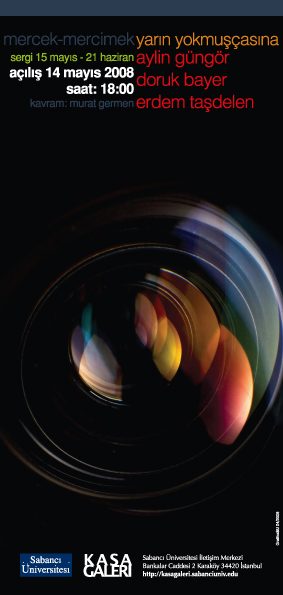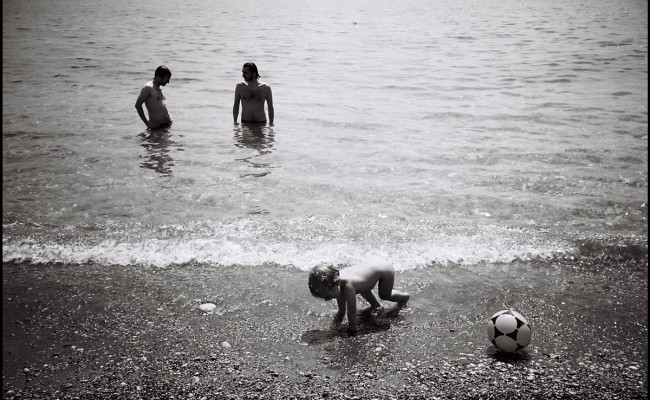The formation process of this exhibit started with Murat Germen calling Erdem Taşdelen. Germen gave Taşdelen just the conceptual outline: “Like there is no tomorrow…” The concept consisted of a mere title and no prior postulations were made. Premeditated hypotheses by Germen were avoided since there was the danger of leading the contributors’ requested concept texts to common grounds. The aim was to make all participants express themselves as freely as possible. Germen requested Taşdelen to find the second artist and pass this person the available information; Taşdelen selected Aylin Güngör. Finding the third artist was second artist’s job and Güngör selected Doruk Bayer. This way, the group was going to be formed following a “transferred responsibility” process; the control of the particular course was going to liberate itself from concept-maker Germen’s monopoly, and gain freedom. It is also possible to see this as an “I heard it through the grapevine” game; what will happen to the words spelled by the first person when they come back to the source: Does the expected result mean good communication; or does the unexpected lead to variety or confusion?
The concept of “Like there is no tomorrow…” followed the below path according the chronological sequence:
“What lies in the depths of the subconscious, what's only remembered as fragments of a vague dream, what's juxtaposed when no stranger is intruding; is what's conjured up without tomorrow's strings attached. In acquiring a sense of tomorrow, we prohibit ourselves from slipping up, bury the unknown desires and anything reason tells us to reject. Without the repercussions of the idea of tomorrow that serves to shape decent behavior and maintain a daily code of conduct, the human psyche would be let loose and the wicked dreams we refuse to accept or fail to clearly recall would show their faces in the form of these staged snapshots. The mind works in such a mysterious way that it constructs an immediate expressive scene but only gives a rapid preview of the moment it has created; the elements seemingly irrelevant but suggestive enough to assure us that there is a lot more involved to the story than the instance we see.
These images are those snapshots that the mind unknowingly captures at speed of light, invoked once one rids oneself of tomorrow's boundaries. Uncertain whether it's memory or fantasy but clearly sure of a dream-like state of the third eye, tomorrow's absence brings about the desires we need to instantly satisfy.” (Erdem Taşdelen)
***
“The phrase ‘Like there's no tomorrow’ is about today. It changes the codes that build today.
Every night we go to sleep with the idea of tomorrow in mind. However, tomorrow is consumed by the present order and it represents a shrinking time which slips through our hand.
Tomorrow is not there anyway. It's taken from us.
What we have to do is to create micro-times for today.
Photographs are the two dimensional appearances of those micro-times.” (Doruk Bayer)
***
“Just because time is running away, people chase it jerking up and down, hoping they can catch it one day. Yet, we have today. Why can’t we feel just relaxed and simply mess around, at least for a day? For once, let’s forget being normal to each other or abnormal from others... Can’t we stop and not impose? How about suspending?
Getting older, being younger... Fighting, running away... He-Man, Skeletor... Being offended, forcing others, escaping today, facing the moment, living far-fetched…
Maybe, the feeling of ‘like there's no tomorrow’ is something that we naughtily take refuge in order to legitimize such confused times.” (Aylin Güngör)
***
Religions, political systems, societies find creating processes of long-term self-reckoning necessary to sustain their existence. Sins are defined to make you feel guilty, if not enough, complicated calculations on education and retirement plans are there to keep you busy; as a final resort, rites are used in order to apply big-scale pressure on people… The aim of all this is to demean the individual, the marginal, the rebel. Even one of the main supposedly-objective props such as history is written with comparable assimilation policies, different nations tell different stories on the same case. Moreover, future decisions are based on these apparently objective but actually very subjective constructs.
This is why I wish we ignore any fear of future imposed on us, generate our own fears and defeat them personally, possess the courage enough to row against mainstream; in short, be able to live “like there is no tomorrow…” (Murat Germen)



